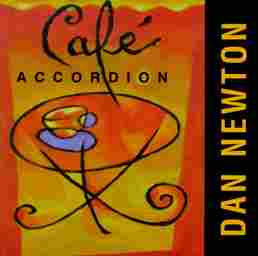
Dan Newton, accordion
CD No. 1: Dan Newton
Cafe Accordion
Dan Newton, accordion
Program:
Say I Do
April Waltz
Eiffel Tower
Traditional: Two French Waltzes
Traditional: Valiakainen-Merimes
Spanish Jenny
Dust Bunnies
Election Rag
Laura's Wedding
Cafe Accordion
Traditional: Telephone Polka
Leeds: Che Lia Lia
Musette
Halloween
Nuevo Brazil
Say I Do
Total Time: 62:31
Released in 1993
Dan Newton's Cafe Accordion Orchestra
Dancing on the Moon
Dan Newton: accordion, vocal, glockenspiel
Diane Jarvi: vocals
Erick Mohring: mandolin, fiddle, vocal
Brian Barnes: guitars
Gordy Abel: bass
Joe Steinger: percussion, drums
Program:
La Valse Musette
Accordion Joe (swing)
A Matelo
La Valse des Niglos (valse musette)
Fandango do Ribatejo
Surullinen Tango
Samba Oleek
Amor del Bajo Corrales (waltz)
Cossaco (forro)
Let's Cumbia
Uralin Pihlaja (waltz)
Au Sommet du Cervin (valse musette)
Lucien Tango
Bohemienne (waltz)
L'Accordeoniste
Ca Gaze (valse java)
Dancing on the Moon (foxtrot)
Total Time: 65:06
Released in 1996
label: Dan Newton
PO Box 50622
Minneapolis MN 55405
Review by
Review by Henry Doktorski:
These two albums by Dan Newton have some really good things going for them; for one, the artwork is exceptional. The first CD, Cafe Accordion -- original compositions by Dan Newton plus a few traditional tunes in the continental style performed by Mr. Newton on a Castiglione 72 bass accordion -- has three absolutely fantastic color paintings by Jim Dryden in a style which reminded me of early 20th century European expressionism. The artwork of the second CD, also by Dryden, is almost as good as the first, although I thought the drawings of the dancers could have been rendered more creatively.Another good thing about these albums are the compositions; I found many of them attractive and interesting. The first album features what seems to be twelve original tunes by Mr. Newton comprising a mix of European folk music, jazz, ragtime, and a pseudo-Latin style in addition to 4 traditional numbers. The second album is stylistically more diverse than the first; it is comprised of 15 traditional dances and only one original Newton tune.
In addition, in "Dancing on the Moon," Newton is joined by five fine musicians who contribute equally to the orchestrations. In my mind, the success of the second album is due to the interesting ensemble. I even liked Diane Jarvi's expressive singing -- a rather low and sultry alto -- perfectly suitable for the plaintive "Surulline Tango" and "Uralin Pihlaja." I must also point out the interesting liner notes from "Dancing on the Moon," which describes a brief history of each piece.
In my opinion, the only disappointment in Cafe Accordion was Newton's playing; unfortunately, a great accordionist he ain't. His skill is at best competent; at worst it is mediocre and at times banal. I couldn't believe how often he changed bellows direction in the middle of phrases -- especially during long sustained notes. I wished he would have waited until the ends of phrases to breath.
Apparently, he doesn't like to breathe; his music goes on and on and on and on without rest, and without dynamic variation. After a few minutes it all sounded the same to me. In my opinion, Mr. Newton could benefit from listening to some of the musette accordionists on the Planet Squeezebox anthology to hear some great folk accordionists.
I must admit that Mr. Newton's playing improved greatly between the release of his first and second albums; Dancing on the Moon sounds much more professional -- it has some real life -- than Cafe Accordion although he still has a noticeable penchant for switching bellows on long sustained notes.
(Special note: there are two terrific surprises at the end of Dancing on the Moon.)
Despite my criticisms, Mr. Newton's CDs will provide perfect background music for parties and will be appreciated by many people -- especially if they have a few drinks and don't listen too closely.
I have been watching Henri's list of CD's, waiting for his reviews of Dan Newton's two CD's and was excited to see that they finally made it to the top and very curious to see Henri's review of them. It's good to see that Henri does indeed call 'em as he sees 'em (American baseball expression). Given that, it also shows that the accordion world is very broad and we can share our love for accordion music even though our tastes may differ very much.
I LOVE THESE RECORDINGS. To me, they represent a goal: if I could only play with the "banality and mediocrity" (H.D.'s words) that D. Newton does! I still have a LONG way to go.
I was very interested to read H's comments about technique. I will listen more carefully and try to learn from them. a technical note: I had a lot more bellows/breathing problems on my 72-bass Castiglione. I think that it was in part a matter of air volume, not to say that my technique does not need work.
Much of the music that H.D. raves over does not move me. I am not a great fan of "the classics" on accordion and a lot of free bass work seems mushy to me. But hey, nobody says that I have to listen to it!
I enjoy the soul and humor in Dan Newton's music. He communicates to me. That, not his technique, his what is important to me.
This message is not a flame of Henri's work. He has his (very educated) opinion and we are grateful for his reviews. AND his review was not completely negative (I suspect because he is a gentleman).
I would just provide an opinion from a mediocre accordion player whose taste runsmore to Django, Bob Wills and Gene Autry than to those other dead guys.
Craig Hollingsworth
L'accordioneste
Gypsy Wranglers
Leverett, Massachusetts
http://www.crocker.com/~tandav
| About The Free-Reed Review |
| Invitation to Contributors / Submission Guidelines |
| Back to The Free-Reed Review Contents
Page |
| Back
to The Classical Free-Reed, Inc. Home Page |